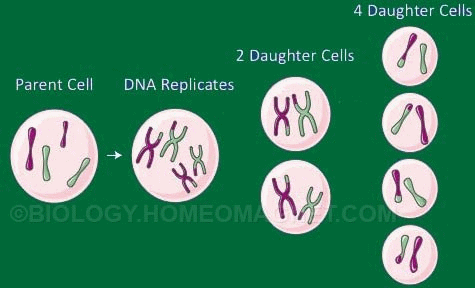You have already know about prophase-I of the meiosis stages. Now you are going to have a discussion about the other meiosis stages.
Metaphase-I: –
The important events of this phase are: (i) in animal cell, spindle is formed between the two centrioles, apart of 180°. (ii) homologous pair of chromosomes are arranged on the equatorial plane in such a way that their centromeres remain on the two sides of the metaphase plate directed towards the opposite poles, while their chromatids remain at the metaphase plate. (iii) the repulsive force between the homologous chromosomes increase which tend to separate them.
Anaphase-I: –
Important events of this meiosis stages are as follows:
i) each of the homologous chromosomes with their two chromatids and undivided centromere moves to the respective poles by the process of disjunction.
ii) Like mitosis the anaphasic movement of chromosomes is initiated by the coordinated effect of the contraction of chromosome fibres and elongation of the contraction of chromosomal fibres and elongation of the continuous fibres also.
iii) The chromosomes are distinctly detached into chromatids which are united at the centromere.
iv) Chromosomes at each pole is reduced to half of the meiocyte, that is the haploid because of disjunction.
v) One of the two chromatids remains unchanged while the other one is changed because of the crossing over.
Telophase-I
In the meiosis stages the important events of Telophase-I are as follows: -
i) Chromosomes reach the two poles and nuclear membrane is reorganised here.
ii) Chromosomes become despiralised, nuclear reticulum and nucleolus reappears.
iii) On the opposite poles two daughter nuclei are formed with haploid number of chromosomes after the reduction of numbered of chromosome.
iv) The threads of chromatin disappear due to hydrated condition of the nucleus.
Cytokinesis-I
Important events of cytokinesis-I are as follows:
i) In this new series stages of cytokinesis-I is same like of mitosis.
ii) The daughter cells have half the chromosome number of the parent cell.
iii) The two daughter cells quickly pass on to the second meiotic division after a very short resting time.
Interkinnesis or second interphase: – it is very short period between the first and second meiotic division without any significant changes.
Second meiotic division: –
in this meiosis stages the two haploid cells formed as a result of past meiotic division undergoes the second meiotic division to produce for identical of Floyd cells. The different stages of second meiotic division are described as follows:
Prophase-II
In this stage the chromosomes are visible again because of dehydration. The chromosomes do not exist in pairs but is made up of chromatids and a centromere. Chromatids are remaining free from each other. The spindle fibres appears at a right angles to the spindle of fast meiotic division towards the end of this stage. The chromosome defied and forms the centriolar spindle in the case of animals cell. The nucleolus and nuclear membrane also disappear.
Metaphase-II
In this meiosis stages the chromosomes are arranged along the equatorial line of the spindle fibres. The centromeres remain on the metaphase plate, while the chromatids are extent towards the poles. These centromeres are attached in the spindle fibres.
Anaphase-II
In this stage the chromosome divide longitudinally with each half having single Chromatid and half of the centromere. The separated chromatids more to the opposite poles due to the shortening of chromosomal microtubules and thus anaphasic movement of chromosomes are initiated.
Telophase-II
In this case of meiosis stages the daughter chromosomes reach the opposite poles. The endoplasmic reticulum resynthesizes the nuclear membrane. The nucleolus organiser synthesise r-RNA and ribosomal protein and forms the nucleus. Four daughter nuclei with haploid number of chromosomes are formed and the nucleus becomes hydrated and the chromosomes disappear.
Cytokinesis-II
The second meiotic division products are always four haploid cells with their chromosomes composter of both parental combination and new recombination character. They become the functional gametes in higher organisms as well as undergo sexual union restore the original diploid chromosome status.
So, meiosis stages maintain the chromosome number in particular species through subsequent generations. It is an essential process for the preparation of sexually reproducing species.
Biology related pages:
- Biology
- Branches of Biology
- Biological classification
- Origin of Life
- Biochemical Origin of Life
- Smallest unit of Life
- Types of Cells
- Eukaryotic Cells
- Cell Cytoplasm
- Golgi body
- Mitochondria
- Function of Endoplasmic Reticulum
- Ribosome Structure
- Lysosomes
- Microtubules
- Cell Wall
- Cell Nucleus
- Cell Nucleus Structure
- Chromosomes
- Chromosome Structure
- DNA Replication
- X and Y Chromosomes
- Cell Membrane
- Cell Junctions
- Cell Division
- Amitosis
- Mitosis
- Meiosis
- Meiosis Stages
- Respiration
- Cellular Respiration
- Process of Respiration
- Digestion
- Genetics
- Gene
- Mendel’s Experiments
- Natural Selection
- The Law of Segregation
- Genetic Variation
- Crossing Over
- Gene Mapping
- Transgenic Plants
- Mutation
- Gene Mutation
- Chromosomal Mutations
- Ecological Community
- Ecosystem
- Structure of ecosystem
- Sweat Glands
- Causes of overpopulation
- Effects of overpopulation
- Population Control
- Air Pollution


